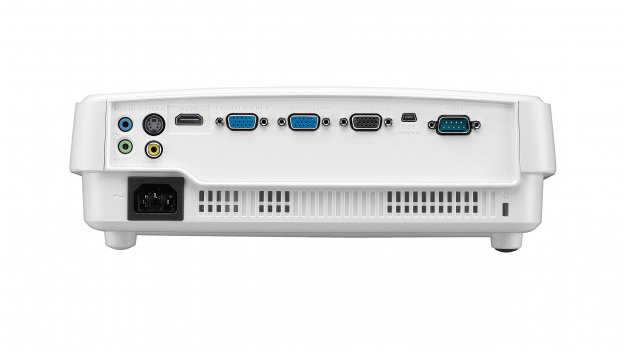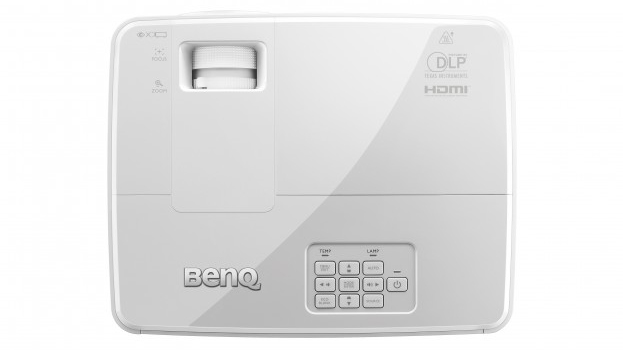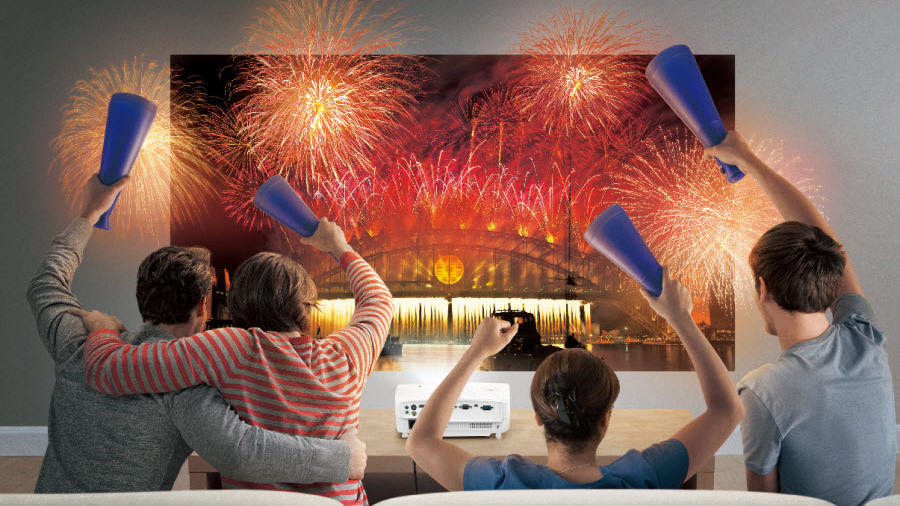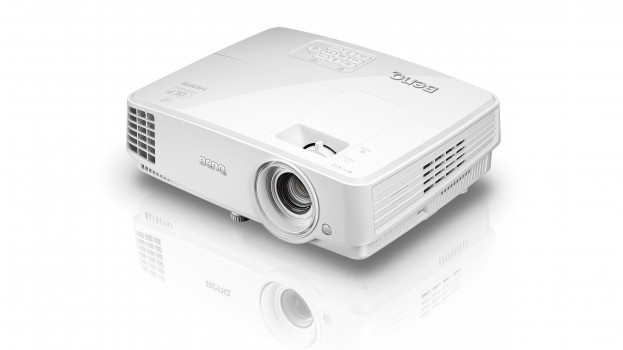TechRadar Verdict
Small, compact and capable of producing some enjoyable images in ambient light, this single-chip DLP projector can extract colorful, crisp images from Full HD content. Native contrast and black levels are average, but this is a great-value way of achieving bright 80-plus-inch images.
Pros
- +
Small, compact design
- +
Bright enough for daytime viewing
- +
Colorful & detailed images
- +
Low price
Cons
- -
Serious rainbow effect
- -
Only one HDMI input
- -
Weak speaker
- -
Lacks lens shift
Why you can trust TechRadar
Who's got the money, time or space for a home cinema projector? They're expensive, tricky to set-up and require a dedicated projection room.
Cue the BenQ MH530 projector.
Affordable and compact, the $527 (AU$819) MH530 is designed to be whipped out from a cupboard to play Full HD movies at a minute's notice.
Design
There's something about this single-chip DLP projector that suggests that it performs best with slides, graphs and pie charts – though it makes a perfectly fine companion for Blu-ray players and game consoles, too. For the frequent traveler, it's certainly easy enough to bring along anywhere you go – its gleaming white 283 x 95 x 222 mm shell weighs just under 5 lbs.
What marks this out as a projector for occasional use isn't just its small size, but the appearance of just one HDMI input. If it's permanently installed with an AV receiver doing the switching, that's probably not the disaster it first appears, but two HDMIs would have helped it leave a more serious impression.
Elsewhere on the rear connections panel it's all about corporate use. The 3.5mm jacks for getting audio in and out are supplied alongside slots for S-video, composite video and D-sub 15pin ports for attaching PCs (and component video devices). There's also a mini USB slot for software upgrades, and an RS232 slot.

Its sole HDMI input, Full HD resolution and BrilliantColor processing suggest serious HD images from a Blu-ray player or games console. For the latter, it's got a built-in speaker, but since it's rated at just 2W, it's strictly for occasional audio during a presentation rather than a full solution. For the home ent crowd, the MH530 is also 3D-ready, although no 3D glasses are supplied in the box.
Sign up for breaking news, reviews, opinion, top tech deals, and more.
Setup
Creating a dead-on image is not as easy as it could be. Tellingly, BenQ doesn’t even think you’ll be bothering with a screen, with ‘wall color’ options creating a bias in the image to counteract your pink, light yellow, light green or blue walls (there’s also a blackboard mode).
Once again, here’s a projector that’s supposedly all about versatility and yet it doesn’t have a manual lens shift lever. Around the focus wheel is just a zoom lever that manages a paltry 1.1:1, with the lens' throw ratio just 1.47-1.62. We managed to quite easily create a 95-inch image from 3m away, but for clarity's sake settled at 80-inches from 2.5m.

The MH530 does have keystone correction, which we've never been a fan of because of the image distortion it creates. However, it is at least very easy to operate on the MH530 – all you need to do is hit the arrow keys on the remote and the picture starts to shift up or down. It’s the same with the left and right buttons for the volume of that built-in speaker.
Its Cinema or sRGB presets are the best starter-points for watching any kind of video, but out of the box it is a touch harsh and generally off-kilter, so be prepared to tweak. There are also some energy-saving modes including Economic, Lamp Save and SmartEco; the latter lessens the glare, while engaging BenQ's BrilliantColor boost color saturation and contrast without any color fringing nastiness.
Performance
The MH530 is bright at least. In the daytime, its 3200 ANSI lumens is a huge plus, and we had no problem using this projector indoors during a bright, sunny day, though that does mean using the highest lamp setting.
The downside to that is that when the lights are low there is only average contrast. It's quoted as 10,000:1, but during our test disc Pan's Labyrinth on Blu-ray there was a lack of definition in murky areas of the maze.
Swapping to SmartEco makes a difference, but it only goes so far, though engaging BrilliantColor also helps.Dark areas of images can look a little gritty – a problem endemic to single-chip DLP projectors – but there's a uniformity to the detail on display. At least the MH530 makes full use of its Full HD 1080 chipset: Motion resolution is impressive, with smooth panning through Pan's Labyrinth, and a vertical judder was obvious only as the end credits rolled.

Despite an all-round acceptable – and arguably good value – picture performance, there’s one major flaw that will make the MH530 a no-go area for those that are sensitive to it: 'rainbow effect'. You either see it or you don't, and if you do, this is not the projector for you.
So is this better for a business professional or an AV fanatic?
The MH530 is a classic hybrid: Natively 16:9 so perfect for projecting movies and TV, its claim of 3,200 ANSI lumens brightness alongside contrast ratio of 10,000:1 makes the MH530 appear a 'movies anytime' kind of a machine.
That said however, the computer-centric slots on the back suggest otherwise, and the performance lacks the nuanced colors and improved contrast that movies require.
We liked
Bright enough to use during the day, the MH530 has clean, crisp, colorful images, and just contrast to compete. If you want to dive into the settings, the MH530 has 3D color management menus (hue, saturation and gain), and a few interesting lamp modes that really help – SmartEco mode in particular, which slashes power consumption by 70%.
We disliked
One HDMI slot is poor return for anything claiming to be for a living room. The lack of a lens shift lever is an oversight, as is the bizarre design of the focus wheel above the lens; for some reason blue light spills out of it, creating a visual effect that is utterly unwanted (we had to place Blu-ray disc case over it for the duration of the review).
We measured a steady 58 decibels of fan noise a few feet away from the MH530, but in practice we barely noticed it during Pan's Labyrinth (though largely thanks to a decent, separate sound system).
Lastly, the MH530's propensity to produce rainbow effect – it is a single-chip DLP projector, after all – will rule it out for some.
Final verdict
Small, compact and capable of producing some enjoyable images in all kinds of ambient light, this single-chip DLP projector needs some tweaks to extract colorful, crisp images, though contrast and black levels are lacking. A great-value way of achieving 80+-inch images, the only real reason to avoid the MH530 altogether is its constant 'rainbow effect'.

Jamie is a freelance tech, travel and space journalist based in the UK. He’s been writing regularly for Techradar since it was launched in 2008 and also writes regularly for Forbes, The Telegraph, the South China Morning Post, Sky & Telescope and the Sky At Night magazine as well as other Future titles T3, Digital Camera World, All About Space and Space.com. He also edits two of his own websites, TravGear.com and WhenIsTheNextEclipse.com that reflect his obsession with travel gear and solar eclipse travel. He is the author of A Stargazing Program For Beginners (Springer, 2015),
